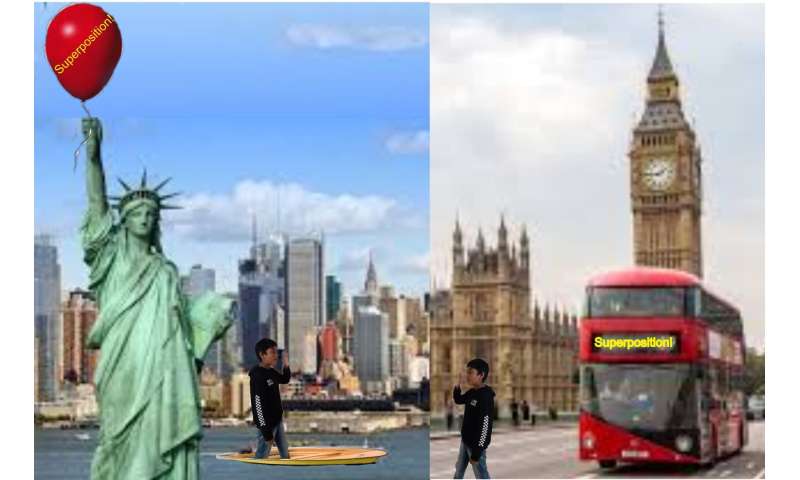Macroscopic spatial superposition

Wouldn't it be fascinating to live in New York and London at the same time? In the standard of everyday life, this is equivalent to daydreaming or sheer fantasy. Nevertheless, this is a perfectly normal phenomenon in quantum mechanics. This is known as the superposition principle, according to which two or more states of an object—for instance, our physical locations in New York and London—can coexist at the same time.
Scientists have performed many experiments confirming the superposition principle with high accuracy. For example, molecules consisting of 2000 atoms have been put into superposition. The question naturally arises: Why in our daily life we do not experience such phenomena? Is it due to technological constraints or something fundamental that prohibits superposition of a massive object? It is true that creating a massive superposition is technically challenging. Nevertheless, according to our current understanding of physical laws, there is no fundamental limitation that forbids superposition of a large object. In fact, there are many theoretical recipes in the literature that describe how to create such a state.
In a recent article, I have proposed a new scheme for creating spatial superpositions using magnetic nanoparticles. In this scheme, a magnetic nanoparticle (20 nm) is levitated in an ion trap at a sub-kelvin temperature. Here, levitation ensures no physical contact between the particle and the surroundings, and a low temperature prohibits thermal disturbances. Overall, these two experimental conditions ensure an enhanced spin coherence time, or equivalently, a prolonged phase synchronization between the spins.
In a second step, I created a superposition of the spin-up and the spin-down state, or crudely, a superposition of the north and the south pole of a magnet. To do so, I relied on another weird quantum mechanical phenomenon known as tunneling. Accordingly, an object or its state, e.g., the north or the south pole of a magnet, can move from one side to the other. This implies that at any point in time and in any one side of a magnet, both the south and the north pole co-exist—in other words, a spin superposition exists. Finally, to create a spatial superposition, I use an inhomogeneous magnetic field. This magnetic field exerts opposing forces on the spin-up and the spin-down states. Additionally, a gradient in the field means that the components of the spin superposition, here the north and the south pole, are physically separated, creating a spatial superposition.
An advantage of my scheme is that many spins (500) work in unison. This means that under a similar magnetic field gradient and a spin coherence time, my scheme can produce the largest spatial separation (5 μm) between the components of the superposition involving nanoparticles. This is orders of magnitude larger than other spin-based schemes. Furthermore, this separation is overwhelmingly larger than the particle itself. This is also in sharp contrast with other existing proposals. Another point of interest is that with appropriate modifications, this scheme can be used to test quantized nature of gravity or quantum gravity. Given that my scheme involves many spins, I note that maintaining a prolonged spin coherence time is challenging.
Finally, being an experimentalist, I look forward to implementing this proposal in the laboratory. A successful realization of this proposal or any other regarding spatial superposition involving nanoparticles would certainly be a huge scientific milestone. Maybe, based upon this success, people could one day live in New York and London at the same time.
This story is part of Science X Dialog, where researchers can report findings from their published research articles. Visit this page for information about ScienceX Dialog and how to participate.
More information: Yaakov Y. Fein et al. Quantum superposition of molecules beyond 25 kDa, Nature Physics (2019). DOI: 10.1038/s41567-019-0663-9
David J. Wineland. Nobel Lecture: Superposition, entanglement, and raising Schrödinger's cat, Reviews of Modern Physics (2013). DOI: 10.1103/RevModPhys.85.1103
Markus Arndt et al. Testing the limits of quantum mechanical superpositions, Nature Physics (2014). DOI: 10.1038/nphys2863
A T M Anishur Rahman. Large spatial Schrödinger cat state using a levitated ferrimagnetic nanoparticle, New Journal of Physics (2019). DOI: 10.1088/1367-2630/ab4fb3
Zhang-qi Yin et al. Large quantum superpositions of a levitated nanodiamond through spin-optomechanical coupling, Physical Review A (2013). DOI: 10.1103/PhysRevA.88.033614
C. Wan et al. Free Nano-Object Ramsey Interferometry for Large Quantum Superpositions, Physical Review Letters (2016). DOI: 10.1103/PhysRevLett.117.143003